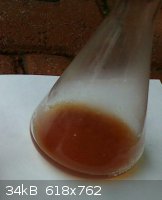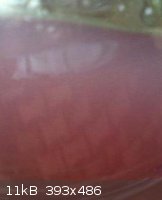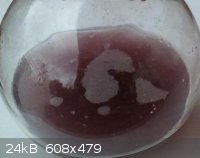blogfast25
International Hazard
    
Posts: 10562
Registered: 3-2-2008
Location: Neverland
Member Is Offline
Mood: No Mood
|
|
Making Ferrates with Household Chemicals
The easiest way of making ferrates is to fuse ferric oxide with an excess KOH and some KClO3 (KNO3 should work but chlorate is more efficient):
Fe2O3(s) + 4 KOH(l) + KClO3(s) --- > 2 K2FeO4(s) + KCl(l) + 2 H2O(g)
Whether you consider KClO3 to be ‘household’ us up to you. European ‘chlorate weed killers’ contain about 50 % NaClO3 which can be substituted
to KClO3 real easily.
|
|
|
HellstormOP
Hazard to Self
 
Posts: 75
Registered: 13-8-2011
Member Is Offline
Mood: No Mood
|
|
Would KClO4 also work? It's not sold in Europe on a regular basis, but when you know the right people, you can get your hands on it^^
And what use have ferrates other to oxidizing ammonia? I mean, for reactions which can be performed at a home lab?
|
|
|
AJKOER
Radically Dubious
    
Posts: 3026
Registered: 7-5-2011
Member Is Offline
Mood: No Mood
|
|
blogfast25:
Thanks for the comment. Pure KOH and NaOH may be difficult for some to acquire. Hence, I avoided the use of NaOH.
Never the less, as I will continue to value your opinion, I warn you to avoid fusion methods for Ferrate production.
As part of my ongoing reading on Ferrates, I do remember a comment that the fusion methods can (frequency not mentioned) result in an explosion. I
would consider this a major downside.
As to other uses of Ferrates, as they are one of the premium oxidizers, you could use them to replace any other oxidizer that you may be missing (like
ozone for an example).
[Edited on 15-8-2011 by AJKOER]
|
|
|
blogfast25
International Hazard
    
Posts: 10562
Registered: 3-2-2008
Location: Neverland
Member Is Offline
Mood: No Mood
|
|
NaOH is easier to get than 'NH4OH' (unless you really consider 4 % to be 'ammonium hydroxide', LOL): local hardware store should do it. KOH? The
streets of eBay are paved with people selling cut throat priced biodiesel KOH. Both are comparatively much, much cheaper than OTC ammonia...
Explosion? Messing with pure, hot strong oxidisers is more risky than using weak watery solutions, of course, but the latter doesn't get you very far.
Recovery of nitrates from a weak and complicated mixture may be your idea of fun but it ain't mine. Still, each to his own...
If you're looking at hypochlorites, consider Ca(ClO)2 which is available as the pure substance.
HellstormOP: KClO4 is sold by Likurg (Poland).
[Edited on 15-8-2011 by blogfast25]
|
|
|
AJKOER
Radically Dubious
    
Posts: 3026
Registered: 7-5-2011
Member Is Offline
Mood: No Mood
|
|
From your local food store, household ammonia is 5-10% (price $1.50 for 1.9 Liters) and commercial grade is up to 30%. NaOH is 99% pure, more caustic
and over the internet approximately one dollar per pound. The bottom line, NaOH costs about the same when you add the cost of shipping (around $12.50
for 2-4 lbs). Some sites also ask you to register.
---------------------------------------------------------------------------------------------------------------
HERE IS A QUOTE FROM AN OLD SCIENCEMADNESS TREAD ON FERRATE PREPARATION:
"chemoleo - 18-5-2004 at 19:34
Well I checked... but I didnt find a detailed method on the ferrate production - via the Fe/KNO3 route. Again it's taken from Jander&Blasius,
preparative inorg. chemistry.
Here it is:
10 g of Fe powder and 20 g of KNO3 are mixed. The latter has to be molten first, then pulverised, to remove any water present.
The mixture is placed ca 1 cm thick (1/2 inch) onto an iron plate. At the edge a 1:1 mixture is added, this is needed for igniting the rest of the
mix.
Using a Bunsen burner, the 1:1 mix is ignited, and the heat is sufficient to ignite the rest of the mix. I am not quite sure why sparklers wouldnt do.
Once the reaction starts, white fumes develop, and the reaction proceeds through the whole mix (therefore it it slow, and rel. safe).
Now and here comes the important bit, potentially explaining why people before had trouble making it:
After cooling down, the product is dissolved in 50 ml ice-cold water, and filtered rapidly.
The red-violet filtrate is immediately mixed with an ice-cold BaCl2 solution. This is allowed to settle (BaFeO4 is not well soluble), and filtrated.
This is then washed with aldehyde-free EtOH/Acetone, and then dried in a desiccator.
Acidified solutions of BaFeO4 produce immediately O2, and are reduced from Fe VI to Fe III."
Link: http://www.sciencemadness.org/talk/viewthread.php?action=pri...
---------------------------------------------------------------------------------------------------------------
ON THE CALCIUM HYPOCHLORITE REFERENCE:
"Bloxam found that calcium ferrate may be produced in solution by gently heating a solution of bleaching powder (calcium hypochlorite) with a small
amount of ferric chloride, but this procedure is very delicate and often fails"
Link: http://library.sciencemadness.org/library/ferrates.html
---------------------------------------------------------------------------------------------------------------
|
|
|
IrC
International Hazard
    
Posts: 2710
Registered: 7-3-2005
Location: Eureka
Member Is Offline
Mood: Discovering
|
|
Is there a simple route along the lines discussed here to produce calcium aluminoferrites? It is almost maddening that endless searching yield very
little other than the myriad of pay for PDF sites. Not being ultra wealthy I avoid such sites. It seems however that information freely available is
severely lacking in these realms of chemistry. Or am I just really lousy at searching?
"Science is the belief in the ignorance of the experts" Richard Feynman
|
|
|
AJKOER
Radically Dubious
    
Posts: 3026
Registered: 7-5-2011
Member Is Offline
Mood: No Mood
|
|
IrC:
Here is a Google Book reference that may be of some assist:
"Cement chemistry" By H. F. W. Taylor
LINK:
http://books.google.com/books?id=1BOETtwi7mMC&printsec=f...
------------------------------------------------------------------------------
[Edited on 16-8-2011 by AJKOER]
|
|
|
AJKOER
Radically Dubious
    
Posts: 3026
Registered: 7-5-2011
Member Is Offline
Mood: No Mood
|
|
Making Ferrates with Household Chemicals
(Deleted Erroneously. Please paste any comments following this, Sorry)
BACKGROUND:
Ferrates are perhaps the strongest oxidizes around yielding mono-atomic oxygen and are capable of oxidizing NH4OH at room temperature. Per a series of
papers in the processing of waste water (see for example, the paper by Karlis Svanks, "Oxidation of Ammonia in Water by Ferrates(VI) and (IV)"
https://kb.osu.edu/dspace/bitstream/handle/1811/36335/OH_WRC... .
One can apparently oxidize ammonia in a normal temperature band with the production of nitrates. One equation given by Svanks, with excess K2FeO4, for
example, directly produces a nitrate:
8 K2FeO4 + 3 NH3 + (n+2)H2O --> 3 KNO3 + 4 Fe2O3.nH2O + 13 KOH
Another reference gives the optimal Ph between 7.5 to 11 and the temperature between 10C to 35C to produce nitrates.
The main issue is how to prepare K2FeO4 as it not commercially available and has a shelf life of about 8 - 9 hours. One cited method is as follow:
2Fe(NO3)3 + 3NaOCl + 10NaOH ->2Na2FeO4 + 5H2O + 3NaCl + 6NaNO3
Unfortunately, the yield is low around 10-15%. However, replacing Na2(FeO4) with the insoluble Barium Ferrate is said to increase ferrate production.
The use of Ferric Nitrate seems to be preferable over Ferric Chloride and Fe(OH)3. The web and above work by Svanks give other possible ferrate
preparations with better yields. There is a recent Iranian Chemical Society paper detailing improvements resulting in higher yields to the Ferric
Nitrate approach. Link is:
http://www.ics-ir.org/jics/archive/v7/4/article/pdf/JICS-7-4...
NEW HOME RECIPE:
My home recipe was based on the following facts: H2O2 is a stronger oxidizer than NaClO and Na2CO3 is a possible alkaline substitute for NaOH. So one
could theoretically use Na2CO3.H2O2 (OxyClean) and say Ferric Chloride + NH4OH to create a fresh Fe(OH)3 precipitate.
My home recipe for FeCl3, used with success here, was to add vinegar to NaClO to form HClO which dissolves Iron to form Ferric Hypochlorite which
instantly decomposes (like Aluminum Hypochlorite) into FeCl3 (the Aluminum hypochlorite actually decomposes on bleaching leaving Alumina in the
fabric). To be honest, this is my explanation of how dilute and weak HClO forms FeCl3, while concentrated HCl only forms FeCl2. However, I am open to
other path explanations, but please perform the reactions yourself first.
My process (I was not really expecting my first attempt using these home brews to actually work given the precision required by the cited preparations
above) was to add about 20 grams of Na2CO3.H2O2 to 50 ml of NH4OH (household strength) and add 20 ml of FeCl3, a reddish-brown pungent chlorine
smelling solution (see picture). Solution remained clear. Shaked and then added addition 50 ml of NH4OH, and the solution turns pink (characteristic
color of Ferrates, see two pictures).
TESTING FOR FERRATES
Upon adding the pink solution to 100 ml of NH4OH, the solution bubbles a little, some gas formation and the solution is completely clear as would be
expected by a ferrate oxidation of NH4OH.
If someone would try to replicate, I would appreciate any comment even if unsuccessful.
  
|
|
|
AJKOER
Radically Dubious
    
Posts: 3026
Registered: 7-5-2011
Member Is Offline
Mood: No Mood
|
|
My shelf supply of HClO may have been produced from the reaction of NaClO and a dilute solution of NaHSO4 (and not Acetic acid).
NaClO + NaHSO4 (dilute) --> Na2SO4 + HClO
to which Fe was added to form FeCl3. For those interested, here is my speculated reaction chain of Fe in HClO based on some old work:
Fe + HClO --> FeO + HCl
HCl + HClO <--> Cl2 + H20
Hence, the observed green chlorine creation. Continuing:
2 FeO + HClO + 3 H2O --> HCl + 2 Fe(OH)3
This is the oxidation of Ferrous Oxide mentioned in the extract (see below) from Mellor. Continuing with my proposed decomposition reaction path:
Fe(OH)3 + 3 HClO --> Fe(OCl)3 + 3 H20
followed with the Fe(OCl)3 oxidizing more iron and decomposing (note, excess Iron should be present):
Fe(OCl)3 + 2 Fe --> Fe2O3 + FeCl3
Normally (per Mellor), the reaction of HClO on a metal oxide is a suggested path to creating the metal hypochlorite. Apparently, however, Iron
hypochlorite either does not exist or immediately decomposes (as I have proposed above with further oxidation). Interestingly, my speculated behaves
parallels the properties of Aluminum Hypochlorite (albeit slightly more stable) which upon contact with a fabric, for example, bleaches and then
immediately decomposes with deposits of Al2O3 into the fabric itself.
The resulting solution has a pungent smell of Cl2 and is reddish brown in keeping with FeCl3 (note, FeCl2 is yellow in aqueous solutions).
REFERENCE: "A comprehensive treatise on inorganic and theoretical chemistry, Volume 2 By Joseph William Mellor
EXTRACT
"Iron filings immediately decompose hypochlorous acid with a brisk effervescence produced by the evolution of chlorine; the iron is partly oxidized
and in part dissolved as chloride without the formation of any chlorate. A. J. Balard commented on this: "The greater number of other metallic
substances do not decompose hypochlorous acid, and I am yet entirely ignorant of the cause of the peculiar behaviour of iron." P. Grouvelle passed
chlorine through water with iron hydroxidelin suspension and a bleaching liquid along with ferric chloride was produced, and he found the liquid
retained its bleaching properties after boiling for a quarter of an hour; but A. J. Balard failed to confirm this statement; he could not make ferric
hypochlorite either (i) by the action of hypochlorous acid on iron hydroxide, for hypochlorous acid does not dissolve ferric oxide; or (ii) by the
action of calcium hypochlorite on ferric sulphate, for calcium sulphate and ferric oxide are produced. Hence, adds A. J. Balard, "ferric hypochlorite
cannot exist;" the results by P. Grouvelle are due to the formation of ferric chloride and hypochlorous acid in dil. soln.; when the mixture was
heated, a portion of the acid distilled off, and the reaction which occurred with the cold soln. was reversed, for ferric oxide and chlorine were
formed. Ferrous oxide is oxidized to ferric oxide by hypochlorous acid."
A free google book. Link:
http://books.google.com/books?pg=PA275&lpg=PA275&dq=...
____________
|
|
|
AJKOER
Radically Dubious
    
Posts: 3026
Registered: 7-5-2011
Member Is Offline
Mood: No Mood
|
|
Great news! Replicated the experiment with success even with significant procedural differences, which apparently did not even matter!
I first created new batch of Ferric salt by slowly dissolving some Iron (from a magnet) in a mixture of NaClO + dilute solution of NaHSO4. When Fe
bubbling reaction appeared to slow after about two hours, I added more NaClO. Then, in a plastic bottle I add the solution to NH4OH, covered the
container and shook to dissolve the white cloud of NH4Cl. Added more excess NH4OH. In other words, I created the Fe(OH)3 first. I then added Sodium
percarbonate (OxiClean, formula: Na2CO3. 3/2H2O2 ) and within a minute the solution turns pink.
My comment on this method is that the H2O2 appears to be a superior oxidizer. The results suggest that the Fe(OH)3 is oxidized to a Ferrate in an
efficient and robust manner as compared to some other preparation methods.
Based on the hypochlorite reaction, I assuming the Ferrate production based on the new process to proceed as follows:
Fe(OH)3 + [Na2CO3. 3/2H2O2] + 2 NH4OH --> Na2FeO4 + 4 H2O + (NH4)2CO3
[Edited on 17-8-2011 by AJKOER]
|
|
|
tetrahedron
Hazard to Others
  
Posts: 210
Registered: 28-9-2012
Member Is Offline
Mood: No Mood
|
|
could someone with free access to wiley upload this resource about ferrates? allegedly it also contains information on the oxidation of ammonia to nitrate by ferrate..thanks
|
|
|
Poppy
Hazard to Others
  
Posts: 294
Registered: 3-11-2011
Member Is Offline
Mood: † chemical zombie
|
|
Considering the low yields, is it correct to assume the addition of ammonia as buffering the production of the ferrate, in that a 15% yield first
decomposes all the ammonia it could so that more 15% can be formed from the left over reagents and so on until gradatively all (or nearly all, at
best) the ferrate has been consumed?
What are the effects of ferrate on urea? (eq. not balanced found it to hard to properly attach stoichometric coeficients)
K2FeO4 + CO(NH2)2 --> CO2 + KNO3 + H2O + Fe2O3 + KOH
This would pose a short on making nitric acid via NaCl.
|
|
|
tetrahedron
Hazard to Others
  
Posts: 210
Registered: 28-9-2012
Member Is Offline
Mood: No Mood
|
|
Quote: Originally posted by Poppy  | Considering the low yields, is it correct to assume the addition of ammonia as buffering the production of the ferrate, in that a 15% yield first
decomposes all the ammonia it could so that more 15% can be formed from the left over reagents and so on until gradatively all (or nearly all, at
best) the ferrate has been consumed?
What are the effects of ferrate on urea? (eq. not balanced found it to hard to properly attach stoichometric coeficients)
K2FeO4 + CO(NH2)2 --> CO2 + KNO3 + H2O + Fe2O3 + KOH
This would pose a short on making nitric acid via NaCl. |
ammonia in excess is mainly oxidized to nitrogen.
|
|
|
AndersHoveland
Hazard to Other Members, due to repeated speculation and posting of untested highly dangerous procedures!
    
Posts: 1986
Registered: 2-3-2011
Member Is Offline
Mood: No Mood
|
|
Ferrates are powerful oxidizers, but they're not quite that powerful. I'm fairly certain they do not release "mono-atomic oxygen". Many old
chemistry books claimed that the reducing action of zinc combined with hydrochloric acid was due to the formation of "mono-atomic hydrogen". Later
researchers showed that this was not true.
The reduction potential of ferrate, stabilised under alkaline conditions, is 0.72v.
While being acidified, which leads to decomposition and liberation of oxygen, the reduction potential of the Ferrate is about 2.20v.
Here are the reduction potentials of some other oxidizers for comparison:
Permanganate (acidified) 1.68v
Hydrogen Peroxide (acidified) 1.78v
Ozone (aqueous acidic solution) 2.08v (it's only 1.24v in pH neutral solution)
persulfate radical 2.6v
(acidified persulfate is only 2.01v unless the solution is boiled)
Hydroxyl radical 2.80v
Fluorine 2.87v
I rather suspect that in several reactions that suppossedly create oxidizing radicals, where iron ions are used as the catalyst, the actual oxidizing
agent responsible is the transient formation of ferrate (either VI or some slightly lower oxidation state), not the formation of any radicals. For
example, it is commonly claimed that the oxidizing power of hydrogen peroxide with iron ions as a catalyst is due to the formation of hydroxyl
radicals, or that the catalytic action of iron ions in increasing the oxidizing strength of persulfate is due to the formation of persulfate radicals.
I'm not saying let's go kill all the stupid people...I'm just saying lets remove all the warning labels and let the problem sort itself out.
|
|
|
platedish29
Hazard to Self
 
Posts: 76
Registered: 2-9-2012
Member Is Offline
Mood: absorbing CO2
|
|
reaction mechanism
Considering reaction including voltages, radicals and mono-atomics scales needs at least considerations about the lability of the ferrate ion, not
just reaction product and speed. Iron III is said to be very labile, maybe ferrates are labile too? With a bit more theory we could perhaps look inner
in the subject.
There ARE chemical methods to tell that.
|
|
|